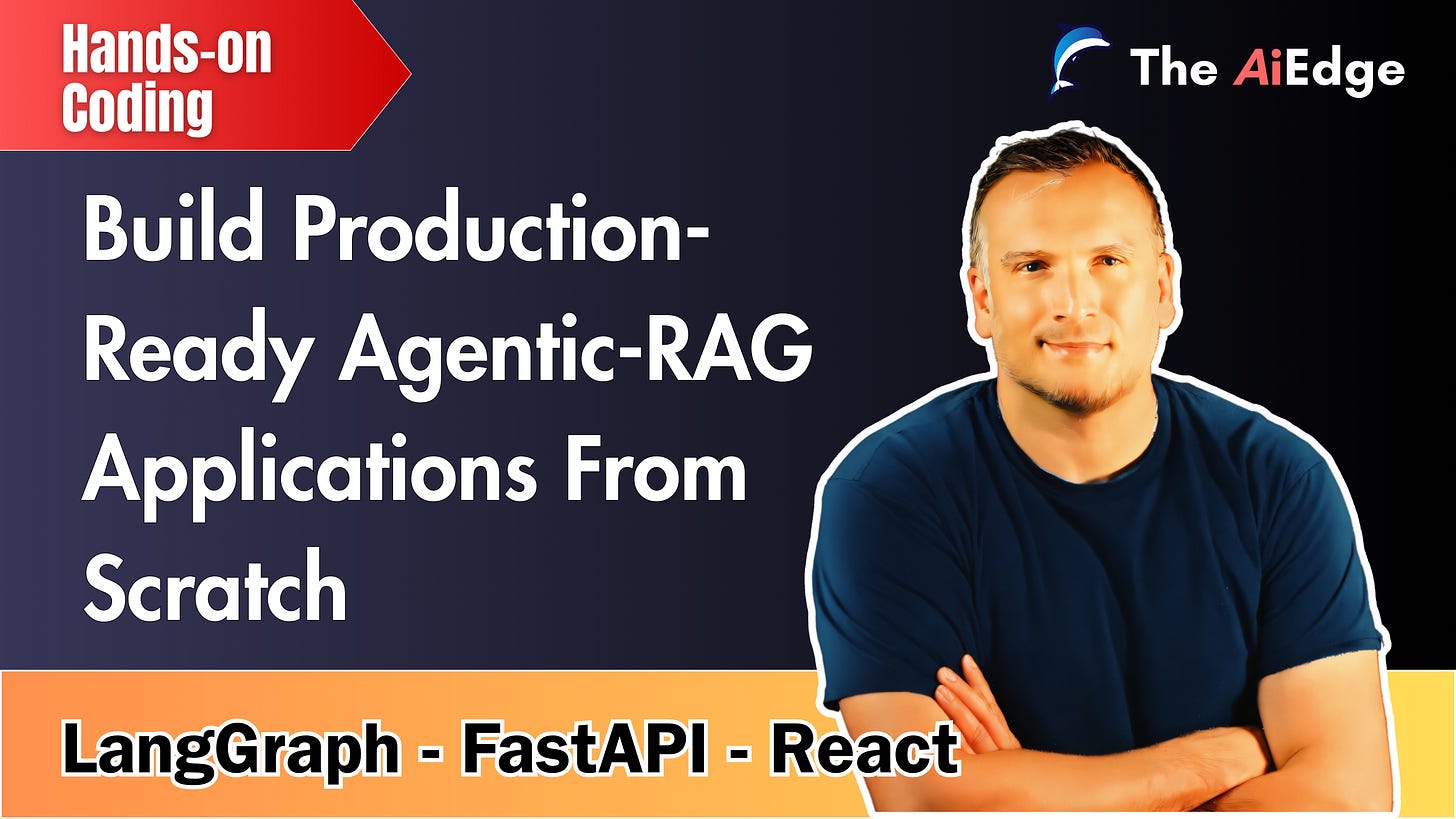New Course: Build Production-Ready Agentic-RAG Applications From Scratch
End-to-end: orchestrate and deploy agentic Retrieval-Augmented Generation with LangGraph, FastAPI, and React frontend in 2 weeks.
On Saturday, September 27th, I am launching a new course: Build Production-Ready Agentic-RAG Applications From Scratch! This is a fully hands-on course where we are going to deploy a production-ready Agentic-RAG application with LangGraph, FastAPI, and React! The first 30 people to sign up will get a 20% discount by applying the promo code FIRST20! So make sure to sign up early:
From Prototype to Production: Ship Reliable and Scalable RAG Pipelines
The Real-World AI Engineering Roadblocks You Face Today
👋 Prototype → Production Gap — Moving from a notebook demo to a secure, observable, multi-tenant service requires orchestration, evals, guardrails, and ops most teams lack.
👋 “Easy RAG” vs “Reliable RAG” — Anyone can retrieve-then-generate; making answers faithful, fresh, fast, and cost-controlled under real traffic is the hard part.
👋 Framework Overload — The ecosystem is noisy; you need clear criteria (maturity, extensibility, latency, cost) and reference patterns to choose confidently.
👋 It’s Software Engineering First — Success hinges on clean interfaces, tests, typed configs, tracing, CI/CD, and change management—not just prompts and models.
👋 From Laptop to 1M Users — Scaling demands streaming, batching, caching, autoscaling, and SLOs, or your p95 explodes and costs spiral.
How this course will help you
✅ Ship a real Agentic RAG app, not a demo — Stand up an end-to-end stack—LangGraph → FastAPI → React, that runs locally today and deploys via a clean, fork-and-ship monorepo.
✅ Make retrieval dependable, not lucky — Adopt schema-aware chunking, strong dense embeddings with sensible metadata filters, and context packing with citations so answers stay faithful, fresh, and concise.
✅ Harden agentic workflows — Design a typed LangGraph state and build nodes for rewrite → retrieve → rerank → synthesize → cite → safety-check, with retries and timeouts so plans don’t loop or stall.
✅ Scale the experience, not the headaches — Enable server-streaming in FastAPI, cap top-k, trim context budgets, and add early-exit rules; deploy with autoscaling so you can serve real traffic without infra fuss.
✅ See enough to fix things fast — Bake in structured logs (no vendor tracing), per-step timing counters, and UI breadcrumbs/citations to follow query → context → answer and spot common failure patterns quickly.
✅ Choose frameworks with confidence — Follow an opinionated reference architecture plus a simple choice rubric (maturity, extensibility, latency, cost, swap effort) so you know when to stick—and how to swap components without rewrites.
✅ Write maintainable RAG code — Use clean module boundaries (ingest / retrieve / rerank / synthesize), typed configs (Pydantic Settings), and sensible secrets/env management so your team can extend it safely.
You’ll walk away with
✨ A running Agentic RAG app (LangGraph + FastAPI + React) in a fork-and-ship monorepo.
✨ An ingestion/indexing pipeline with metadata, hybrid retrieval, and optional re-ranking.
✨ A chat UI with citations, source previews, and conversation memory that behaves.
✨ Deploy scripts and env templates to go live right after class.
✨ A framework choice memo + adapters to swap models/vector stores without starting over.
Bottom line: this isn’t a vitamin, it’s a blueprint you can put in production.
What you’ll get out of this course
Orchestrate complex RAG pipelines with LangGraph and OpenAI API: Build a typed LangGraph that routes rewrite → retrieve → rerank → synthesize → cite → self-check with retries, timeouts, early-exit rules, and real tool calls, exposed as a clean HTTP API.
Build scalable asynchronous applications with FastAPI: Ship async FastAPI endpoints, well-typed request/response models, input validation, and sensible timeouts, ready to run locally and deploy to production.
Implement chatbot interfaces with React: Create a chat UI that shows citations and source previews, lets users scope queries, preserves safe chat history, and handles transient API errors gracefully.
Mitigate hallucinations with LLM judges, structured output, and context engineering: Cut errors via schema-aware chunking, dedupe and budgeted context packing, plus lightweight LLM checks and schema-constrained outputs to verify claims and enforce citations before responding.
Design effective LLM prompts for high-level control on generation output: Write prompts that steer behavior: system prompts, task decomposition, Pydantic/JSON-schema constraints, and clear rules for tone, citations, and safe refusals.
Develop end-to-end RAG applications using the software engineering best practices: Produce a maintainable codebase: clean module boundaries (ingest/retrieve/rerank/synthesize), typed configs, secrets/env management, reproducible local dev, and deploy that mirrors local.




Pricing not suitable for Indian audience